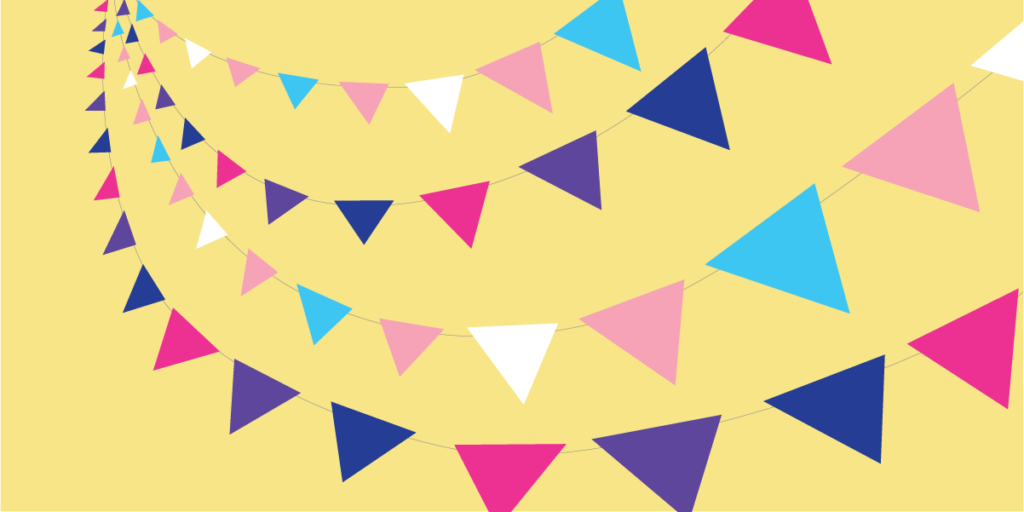Bi+ Intersections
Transgender and/or Nonbinary Folks in the Bi+ Community

Let us be your myth-busters with these cold, hard facts!
Myth: Trans people don’t (and shouldn’t) use the personal label bisexual.
Trans people are sometimes told they shouldn’t use the label bisexual because the bi in bisexual may refer to an exclusive attraction to the binary genders of man and woman. If so, the word would reinforce the gender binary, excluding attraction to people who are nonbinary, genderqueer, agender, and Indigenous genders such as Two-Spirit. Trans and/or nonbinary folks are told they should instead identify as pansexual or queer.
Fact: Many trans and/or nonbinary people identify as bisexual.
Plenty of trans people happily identify as bi (as opposed to pan, queer, or other labels) despite being told they shouldn’t. The definitions of bisexuality most widely used today include, rather than exclude, people of all or no genders. For example, bi+ activist Robyn Ochs defines bisexuality as “the potential for attraction to people with genders similar to and different from [your] own.”
Furthermore, trans folks shouldn’t be told what they can and can’t call themselves. Aud Traher writes about faer own struggles in being taken seriously as bi: “If you want to support trans people like me, don’t erase me or speak over me or cause me harm out of self- righteous [bi-antagonism].”

If you want to support trans people like me, don't erase me or speak over me or cause me harm out of self-righteous [bi-antagonism].
Aud Traher
Myth: Folks who identify as bisexual are not attracted to trans and/or nonbinary people.
Because of the misconception that the bi in bisexual refers to an exclusive attraction to binary genders, it is believed that bi people aren’t attracted to trans and/or nonbinary people.
Fact: Bisexual people can be attracted to trans and/or nonbinary people.
The outdated definition of bisexual doesn’t have a say in who bi folks are attracted to. In addition to adopting definitions like Robyn Ochs’s, many bi people—both trans and cis (a gender identity that matches sex assigned at birth)—have updated their own definitions to more explicitly include people of all or no genders, including genderqueer people, nonbinary people, agender people, and people with Indigenous genders.
Myth: The bi community fetishizes trans people.
This misconception is based on two inaccurate assumptions:
- Bi+ people will never be satisfied in a relationship with only one gender at a time.
- Trans people’s bodies are seen as more than (or less than) the gender(s) they identify as. (Or none at all, in regards to agender people.) Some people think trans people are “the best of both worlds”—even when the trans folks in question may not identify with any of those “worlds.” This misconception further reinforces the gender binary with ideas of what masculine and feminine mean in physical bodies.
Fact: Bi+ folks aren’t attracted to trans people just because they are trans.
Bi+ people date trans people, but aren’t inherently more sexually attracted to them just because of their own bisexuality. This attraction can occur for any number of reasons, such as personality, similar interests, and physical features unrelated to transness itself.
Bi+ people often know what it feels like to be excluded, erased, or invisible, and don’t want others to be treated the same way.
Myth: The bi+ community isn’t welcoming to trans and/or nonbinary people.
Because of the misconceptions already discussed, some people think bi+ folks are trans-antagonistic, and therefore the community will not be welcoming to trans and/or nonbinary folks.
Fact: The bi+ community is not inherently trans-antagonistic.
While there are trans-antagonistic people in any group, the bi+ community is not inherently trans- antagonistic. As already mentioned, many trans folks identify under the bi+ umbrella. Additionally, bi+ people often know what it feels like to be excluded, erased, or invisible, and don’t want others to be treated the same way. The bi+ community often puts effort into supporting trans organizations and individuals through advocacy, donations, volunteer work, and thoughtful inclusion at events.
These concerns about trans-antagonism show that all communities need to make an effort to welcome and support trans people in every aspect of life.
How to Support the Trans and/or Nonbinary Community
Volunteer at trans-specific organizations and for trans causes.
Donate to trans-led organizations and to crowdfunding efforts for trans causes.
Ensure trans people are in decision-making and leadership positions in your organizations, especially when discussion directly involves trans needs or inclusion.
Make sure your events are welcoming to trans people: provide all-gender restrooms, if possible, and greet the audience in gender- free ways (e.g. “Good evening, friends”).
Help educate others about the importance of trans inclusion, and correct them if they say something harmful or trans-antagonistic.